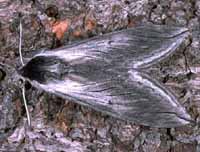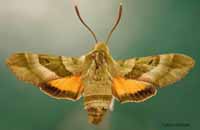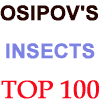Wahkiakum County
Sphingidae
Seventeen Sphingidae species are listed for Washington. Not all of
the species are reported or anticipated in Wahkiakum County
in southwestern Washington. It is hoped that
this checklist, with the thumbnails and notes, will help you
quickly identify the moths you have encountered.
The Cascades seem to be a barrier to some of the more eastern species.
A "WO" after the species name indicates that
I have no confirmed reports of this species in Wahkiakum County, but I
(William Oehlke) expect that this moth is or might be present.
Please help me develop this list with improved, documented accuracy by
sending sightings (species, date, location), preferably with an
image, via email to
Bill Oehlke.
Sphinginae subfamily
Sphingini tribe:
 |
This species is possibly present (unreported) and larvae feed on tomatoes and go by the common name of
"Tomato Hornworms". |
 | The upperside of the forewing is dark grey to black with a
paler costa and pale area from the base to the wing's centre.
Prefered habitats include montane woodlands and mixed chaparral-type
vegetation. |
 |
The upperside of the forewing has a narrow black subterminal line
bordered by a white inverted V-shaped line on the outside, and a
black line running inwards from the apex of the wing.
It is most often found in montane woodlands and along streamcourses. |
Smerinthini Tribe:
 |
The grey-blue eyespot of the hindwing gives this species its name.
Larvae feed on birches, willows, cherries and oaks.
The outer edge of the forewings is quite scalloped. |
 |
If you have willows and poplars nearby, you've probably got populations of
the Cerisyi's Sphinx. The hindwings are quite striking.
|
Bob Pyle writes, "Smerinthus cerisyi, one-eyed sphinx:
photographed in Gray's River, Wahkiakum Co.,
(I have collected this here previously from time to time).
6 June 2006, J. Durrah."
Macroglossinae subfamily
Dilophonotini tribe:
 |
Hemaris diffinis WO, the Snowberry Clearwing or Bumblebee Moth
Although not officially reported from Wahkiakum, this day flying moth
is widely distributed in Washington and northwestern Oregon.
I suspect I will get reports from Wahkiakum County. |
Macroglossini tribe:
 |
Hyles gallii WO,
the Bedstraw Hawk Moth or Gallium Sphinx
This species is not officially reported from Wahkiakum County, but if
you have Gallium or Epilobium, you might have
localized populations of this species. |
 |
Hyles lineata BP, the White-lined Sphinx
This species is very widespread. It can be seen flying during the day,
into the evening and also at night.
The highly variable larvae are often found in people's gardens. |
 |
Although not officially reported from Wahkiakum County, this day flier,
April-June, prefering oak woodland and pine-oak woodland in foothills,
is possibly present. Moths nectar at a variety of flowers in the afternoon.
|
 |
Proserpinus flavofasciata WO,
the Yellow-banded Day Sphinx
This day flier is not officially reported from Wahkiakum, but it has
been found to the south in northwestern Oregon in meadows near
coniferous forests. |
|
|
Here are sighting records and general information for
Sphingidae in Wahkiakum County in
southwestern Washington.
Bob Pyle BP reports 2005, "The only sphingids we've
recorded are H. lineata and S. cerisyi. Thea saw a
possible Manduca last week, but
was far from certain. We should get H. diffinis, and will
watch still harder for others."
Enjoy some of nature's wonderments, giant silk moth cocoons.
These cocoons are for sale winter and fall. Beautiful Saturniidae moths will emerge the following spring and summer.
Read Actias luna rearing article. Additional online help available.
Use your browser "Back" button to return to the previous page.
This page is brought to you by
Bill Oehlke and the
WLSS. Pages are on space rented from Bizland. If you would like
to become a "Patron of the Sphingidae Site", contact Bill.
Please send sightings/images to Bill. I will do my best to respond to
requests for identification help.
 | 
Show appreciation for this site by clicking on flashing butterfly to the left.
The link will take you to a page with links to many insect sites. |
